

EHRA worked with the District to create a comprehensive Parks Master Plan, which included recommendations for the development of over two miles of hike/bike trails adjacent to local streets, and within flood control and utility pipeline easements. The District began implementation of the Plan by prioritizing the beautification of West Road, a major arterial street that runs through the District.
EHRA was selected as one of two firms to provide professional surveying services under contract to Houston Community College System.
In 2006, Caldwell Companies sought to create Towne Lake as a community where residents and services could be connected by water. Their vision included boat docks and marinas augmenting traditional walking trails to navigate a vibrant residential community. EHRA was the perfect partner to take Caldwell Companies’ vision and create this livable suburban oasis.
EHRA performed preliminary drainage area delineations for nine creek crossings and calculated approximate 100-year flows for each culvert crossing. Culvert structures were sized for each of the six crossings, ranging from 48” round pipe culverts up to dual 5’x5’ box culverts.
EHRA completed a site-specific planning and visioning study for the proposed 470-acre San Jacinto Boulevard District (SJBD) in Baytown, Texas.
A lighthearted guide to understanding your colleagues from another planet.
As a planner working among engineers, I sometimes feel like I’m speaking an entirely different language, and not just because I struggle with runoff coefficients or load-bearing calculations. As the title of this reflection suggests, engineers and planners tend to approach problem solving from far away starting places. How far, you might be wondering? Well, I’m not talking about a galaxy far, far away—maybe just a planetary system or two at most. But a small difference in perspective can lead to big differences in how we prioritize tasks, communicate with clients and ultimately how we define success.
Most readers will be familiar with the popular 1990s book, Men Are from Mars, Women Are from Venus. Even if you haven’t read it, the theme is obvious: Men and women have fundamental differences in the way they communicate, what motivates them, how they deal with stress and so forth. While the central idea of the book is generally true as a pattern and not universally true for every individual (my disclaimer), understanding how men and women tend to think, react and behave is undoubtedly helpful knowledge, especially for the men.
So too it is important to understand the tendencies of planners and engineers. Many of the differences are obvious when we stop to think about them, but we lead busy professional lives and there’s not always time between back-to-back meetings and end-of-day deadlines to analyze what we just heard in the previous weekly meeting. What follows are not universals, but helpful reminders for navigating your next encounter with an extraterrestrial—or an Earthling (for our Martian readers out there). And before you ask, “Hey! What about the landscape architects, surveyors and construction guys?” I think it is safe to group the landscape architects with the planners, and the construction guys with the engineers, generally. But the surveyors are a totally different breed that we are all still trying to figure out.
Planners tend to be visionaries. We begin with the end in mind. And even though many of us have been trained in code writing and precise technical drafting, the vision is what motivates what we do, especially when it comes to neighborhoods. We imagine vibrant communities, walkable streets and public spaces that bring people together. We see our plans more as works of art rather than blueprints. That centerline radius of 547.8’ might be the perfect curve to align the entry drive with the rec center and we don’t want the surveyors to change it (on second thought, I might know what planet the surveyors are from). Knowing that aesthetic change may cost a little extra, no one is more determined than a planner to make it work within the budget. Doing what it takes to create the best place to live is what we, as one team, are focused on. Admittedly, a planner’s passion can have unintended consequences or additional challenges, but it’s important that engineers understand where we are coming from and why we value so greatly the things we do.
While planners start off thinking pie-in-the-sky, engineers meanwhile keep us grounded, literally. As realists, they tend to think in terms of cubic feet of dirt, cut and fill and side slope percentages—all crucial components to creating livable and functional places to live. The first time they review a bubble plan, their minds are filled with calculations, code requirements and the cost implications of every single line drawn. It’s not uncommon for a planner to get the first markup back from the engineering team and die a little inside when the Water Plant and Wastewater Treatment Facilities have basically become the entry features for Phase 1 (from the planner’s perspective). But as someone reminded me once, the toilets have to flush. However, planners will continue to ask if we can run water uphill. Just once.
You might think that the engineer’s respect for and strict adherence to the laws of gravity would earn them the honor of being considered the earthling in my analogy, but ultimately, I think that title belongs to the planners, who stubbornly ask themselves the question “what will a person experience” each time they design a new place.
In the end, planners may be from Earth and engineers from Mars, but the real magic happens when those worlds collide. We may speak different languages, but together, we build something far greater than the sum of our parts. As a true multidisciplinary firm, the EHRA team brings the full galaxy of ideas to the table: grounded creativity, structured imagination and a shared mission to deliver the best solutions to the communities we serve. Solutions that are as visionary as they are viable. Because when Earth and Mars team up? That’s when real innovation launches.

